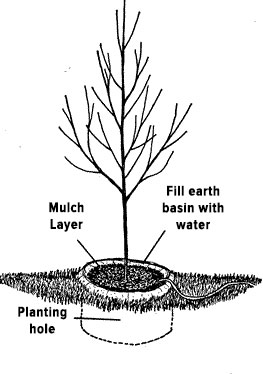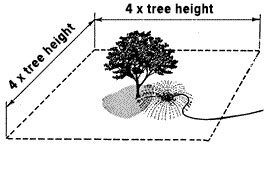How do I water trees?
Do:
Apply water across the soil surface and let it soak into the soil. Surface soaking allows tree roots more chances to absorb any water, helps maintain soil health, and helps maintain essential element cycling and transformations in the soil.
The best ways to water trees are with a soaker hose or trickle (drip) irrigation, which you turn on and off. Even a garden hose, moved often, can provide a good soil soaking.
Take care to water the surface beneath the tree’s canopy, but keep water off the leaves. Foliage that is watered can be sun-scalded or develop fungal foliage disorders.
Don't:
Deep water a tree with a pipe or wand stuck into the soil 12-24 inches. Most of the tree's absorbing roots are in the top foot of soil. Applying water deeper than this level misses the active roots and allows water to drain away from the roots, wasting efforts and water.
Water Stress
Water stress occurs when a tree loses moisture through its leaf surface and is not able to replace it. Windy conditions can accelerate the stress process. Symptoms include leaf droop and the eventual drying of the leaf. Water stress may not kill a tree outright, but it could weaken a tree and predispose it to other insect and disease problems.
Newly planted trees are the most susceptible to water stress and should be monitored closely. Many times these trees have lost a percentage of their root system in the digging process and are not very efficient with water uptake. Concentrate on watering just the basal root system of new trees and check often with a soil probe to inspect water dispersal.

How much water do I use?
Try to replicate a rainfall of about 2 inches a week. If there is enough precipitation to wet the soil 2-3 feet deep, don’t apply additional water. If natural rainfall falls short of a full soaking, only water enough to wet the soil 2–3 feet deep.
If you use a sprinkler system, you can estimate this amount of water by placing several small containers under the canopy of your trees. When the average depth in the containers equals 2 inches, you are done with that tree. You can also probe the soil to a depth of 6–8 inches to make sure the soil is saturated to that depth.

When should I water?
The best time to water is at night from 10 p.m. to 8 a.m. Trees "refill" during nighttime hours. Watering at night allows effective use of applied water and less evaporative loss, assuring more water moves into the soil and tree. The next best time to water is in late afternoon when the leaves are dry and evaporation potential is not at its daily peak.
Plan to water newly planted trees each summer for the three years after planting. After that, the tree should be able to survive on its own without supplemental water.
Evergreen trees always will lose water during the dormant season, so they should be watered during winter droughts. Because temperatures are low and relative humidity is typically high, much less water is required in the dormant season, but water still is needed. Do not water when the soil surface is less than 40 degrees Fahrenheit.
Can trees be over-watered?
The clay soils common in Missouri don't drain well. When these soils are over-saturated, water displaces what little oxygen is available, and the tree's root system "drowns."
Well-established trees rarely are affected, but newly planted trees must be watched closely by probing the soil to a depth of 6-8 inches. Research, however, has shown that many more trees are lost to dryness than from over-watering. Keep your soil moist but not soggy.
Facts about trees and water
- Living plants are up to 90 percent water.
- About 99 percent of the water taken up by tree roots evaporates from the leaves through transpiration.
- A mature tree can lose hundreds of gallons of moisture a day.
- An ideal soil for root growth is 1/4 water, 1/4 air and 1/2 solids.
- Browning, wilting, scorch and dieback after very hot and cold weather usually are caused by lack of available water.





















